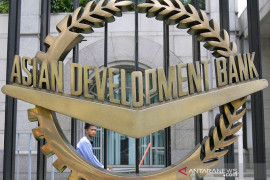Indonesia has to import about 70 percent of its milk need while its fresh milk production is still low at about 1.4 million liters per day. Its per capita consumption is also low at about 11 liters a year.
Agriculture Minister Suswono said that the average milk consumption rate of the Indonesian people was still very low compared with those of other countries, namely about 11 liters per capita per year.
"The Indonesian people only consume about 11 liters of milk per capita per year. It accounts for only one-third of Malaysia`s average milk consumption which is about 36 liters per capita per annum, let alone if it is compared with those of the Unite States and the Netherlands," the minister said after attending the National Milk Day 2011 in Semarang on Saturday.
The present rate of Indonesian people`s per capita milk consumption has actually increased compared with that about four years ago. This was thanks to the people`s awareness of the health benefits of milk.
In 2007, Indonesian per capita milk consumption was about 7.7 kg a year and this increased by about 6 percent in 2008. There are three types of consumer products that continue to dominate the market, namely powdered milk, sweetened condensed milk, and liquid-ready to drink milk.
Consumption of liquid milk, powdered milk, and sweet condensed milk were growing by 20 percent, 10-12 percent, and 20 percent respectively in 2007.
By 2009, the per capita milk consumption of the people relatively remained low as compared to those other countries, namely about 10 liters per capita a year. This is far below that of Malaysia which reached 30 liters per capita per annum.
Last year, the Indonesian per capita milk consumption only rose slightly to 11 kg a year while that of Malaysia has risen to 36 liters.
Therefore, the government continues to make efforts to increase the people`s average milk consumption rate, among others by raising the people`s awareness of the benefit of consuming milk through celebrating the Nusantara Milk Day.
The Nusantara Milk Day was on Saturday observed in Semarang, Central Java, where the function carried a theme: "A Glass of Fresh Milk Per Day," he said.
Through the observance of the Indonesian milk day, the people are expected to raise their awareness of the benefit and the need to consume milk. But for this, efforts must be supported by increased local milk production, as so far the country still imports most of its need.
Minister Suswono said that about 70 percent of the country`s need for milk was still imported while the domestic national milk production could only meet 30 percent of the people`s need.
The minister said that due to its condition, the country`s milk production was not yet able to meet the people`s need for milk because the milk production business at home was still done in small scale.
"We also need to improve the country`s milk production management, such as the need to improve the hygiene aspect and its originality," the minister said.
Since in the past several years, Indonesian milk production has not yet increased significantly. Indonesian fresh milk production remained stagnant in 2007 at 1.2 million liters per day and could only meet 25 percent of overall Indonesian milk demand.
The gap was fulfilled from imports. Despite the soaring price of non fat dry milk as well as whole milk powder in the international market, imports of non fat dry milk are forecast to continue growing as demand remained firm.
According to a ministry of agriculture official, Indonesia still had to import 76.5 percent of its milk need in 2009 as domestic production could only meet 23.45 per cent of the need.
Local milch-cow farmers produced some 1.3 million to 1.4 million liters of milk per day, of which 97 percent were supplied to domestic milk processing industries.
Economic and cooperative observer Sri Edi Swasono said the government should provide a subsidy for about 120,000 local milk producers in Java, and give them the needed facilities so that domestic milk producers and industries would develop well.
Thousands of milk producers are grouped in about 95 centers of cooperatives units under the Indonesian Milk Cooperatives Movement.
Based on data quoted by the online media the CattleSite.com, Indonesian milk production is sourced from around 320,000 cattle largely located in three milk-producing areas in Java.
West Java`s dairy cooperatives used to produce the highest amount of milk, but the position was taken over by East Java`s dairy cooperatives in 2004 when the price of beef skyrocketed so that farmers received more from culling their dairy cattle for beef versus looking after the cattle for milk.
By 2007, West Java`s dairy cooperative produces approximately 400,000 liters of milk per day while East Java produces 600,000 liters of milk per day. The balance is produced by Central Java and other parts of Indonesia.
In order to boost local milk production, Central Java Governor Bibit Waluyo suggested on Saturday that milk imports from other countries should be reduced but imports of milch cows must be increased, young cows.
"About 70 percent of the national need for milk is imported while another 30 percent are met by locally produced milk," the governor said.
He said that the big volumes of imported milk had caused local milch cow breeders to face difficulties in developing their business because imported milk put on the market usually had better quality and cheaper price.(*)
Reporter: Andi Adussalam
Editor: Aditia Maruli Radja
Copyright © ANTARA 2011











